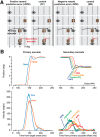Reward Prediction Error Modulates Saccade Vigor
- PMID: 31015343
- PMCID: PMC6670245
- DOI: 10.1523/JNEUROSCI.0432-19.2019
Reward Prediction Error Modulates Saccade Vigor
Abstract
Movement vigor, defined as the reciprocal of the latency from availability of reward to its acquisition, changes with reward magnitude: movements exhibit shorter reaction time and increased velocity when they are directed toward more rewarding stimuli. This invigoration may be due to release of dopamine before movement onset, which has been shown to be modulated by events that signal reward prediction error (RPE). Here, we generated an RPE event in the milliseconds before movement onset and tested whether there was a relationship between RPE and vigor. Human subjects (both sexes) made saccades toward an image. During execution of the primary saccade, we probabilistically changed the position and content of that image, encouraging a secondary saccade. On some trials, the content of the secondary image was more valuable than the first image, resulting in a positive RPE (+RPE) event that preceded the secondary saccade. On other trials, this content was less valuable (-RPE event). We found that reaction time of the secondary saccade was affected in an orderly fashion by the magnitude and direction of the preceding RPE event: the most vigorous saccades followed the largest +RPE, whereas the least vigorous saccades followed the largest -RPE. Presence of the secondary saccade indicated that the primary saccade had experienced a movement error, inducing trial-to-trial adaptation. However, this learning from movement error was not modulated by the RPE event. The data suggest that RPE events, which are thought to transiently alter the release of dopamine, modulate the vigor of the ensuing movement.SIGNIFICANCE STATEMENT Does dopamine release in response to a stimulus serve to invigorate the ensuing movement? To test this hypothesis, we relied on the fact that reward prediction error (RPE) is a strong modulator of dopamine. Our innovation was a task in which an RPE event occurred precisely before onset of a stimulus-driven movement. We probabilistically produced a combination of large or small, negative or positive RPE events and observed that saccade vigor carried a robust signature of the preceding RPE event: high vigor saccades followed +RPE events, whereas low vigor saccades followed -RPE events. This suggests that in humans, vigor is partly controlled through release of dopamine in the moments before onset of a movement.
Keywords: dopamine; latency; motor control; reward prediction error; saccade; vigor.
Copyright © 2019 the authors.
Figures




Comment in
-
What Can Saccades Reveal about the Link between Learning and Motivation?J Neurosci. 2019 Nov 20;39(47):9274-9276. doi: 10.1523/JNEUROSCI.1598-19.2019. J Neurosci. 2019. PMID: 31748283 Free PMC article. No abstract available.
Similar articles
-
Modulation of Saccade Vigor during Value-Based Decision Making.J Neurosci. 2015 Nov 18;35(46):15369-78. doi: 10.1523/JNEUROSCI.2621-15.2015. J Neurosci. 2015. PMID: 26586823 Free PMC article.
-
Saccade vigor and the subjective economic value of visual stimuli.J Neurophysiol. 2020 Jun 1;123(6):2161-2172. doi: 10.1152/jn.00700.2019. Epub 2020 May 6. J Neurophysiol. 2020. PMID: 32374201 Free PMC article.
-
Vigor of reaching movements: reward discounts the cost of effort.J Neurophysiol. 2018 Jun 1;119(6):2347-2357. doi: 10.1152/jn.00872.2017. Epub 2018 Mar 14. J Neurophysiol. 2018. PMID: 29537911 Free PMC article.
-
Movement Vigor as a Reflection of Subjective Economic Utility.Trends Neurosci. 2019 May;42(5):323-336. doi: 10.1016/j.tins.2019.02.003. Epub 2019 Mar 13. Trends Neurosci. 2019. PMID: 30878152 Free PMC article. Review.
-
Neural control of on-line guidance of hand reaching movements.Prog Brain Res. 2003;142:155-70. doi: 10.1016/S0079-6123(03)42012-8. Prog Brain Res. 2003. PMID: 12693260 Review.
Cited by
-
Neural mechanisms for executive control of speed-accuracy trade-off.Cell Rep. 2023 Nov 28;42(11):113422. doi: 10.1016/j.celrep.2023.113422. Epub 2023 Nov 10. Cell Rep. 2023. PMID: 37950871 Free PMC article.
-
The Aging Brain & the Dorsal Basal Ganglia: Implications for Age-Related Limitations of Mobility.Adv Geriatr Med Res. 2019;1:e190008. doi: 10.20900/agmr20190008. Epub 2019 Aug 16. Adv Geriatr Med Res. 2019. PMID: 31497780 Free PMC article.
-
Explicit learning based on reward prediction error facilitates agile motor adaptations.PLoS One. 2023 Dec 6;18(12):e0295274. doi: 10.1371/journal.pone.0295274. eCollection 2023. PLoS One. 2023. PMID: 38055714 Free PMC article.
-
How the value of the environment controls persistence in visual search.PLoS Comput Biol. 2021 Dec 14;17(12):e1009662. doi: 10.1371/journal.pcbi.1009662. eCollection 2021 Dec. PLoS Comput Biol. 2021. PMID: 34905548 Free PMC article.
-
Cerebellar complex spikes multiplex complementary behavioral information.PLoS Biol. 2021 Sep 16;19(9):e3001400. doi: 10.1371/journal.pbio.3001400. eCollection 2021 Sep. PLoS Biol. 2021. PMID: 34529650 Free PMC article.
References
Publication types
MeSH terms
Grants and funding
LinkOut - more resources
Full Text Sources
